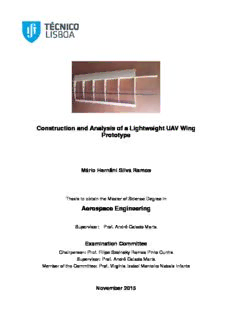
Construction and Analysis of a Lightweight UAV Wing Prototype Aerospace Engineering PDF
Preview Construction and Analysis of a Lightweight UAV Wing Prototype Aerospace Engineering
Construction and Analysis of a Lightweight UAV Wing Prototype Mário Hernâni Silva Ramos Thesis to obtain the Master of Science Degree in Aerospace Engineering Supervisor: Prof. André Calado Marta Examination Committee Chairperson: Prof. Filipe Szolnoky Ramos Pinto Cunha Supervisor: Prof. André Calado Marta Member of the Committee: Prof. Virginia Isabel Monteiro Nabais Infante November 2015 ii Tomyparents,fortheirunconditionalsupportthrougheverystepofmylife. iii iv Acknowledgments I would like to thank my thesis supervisor, professor Andre´ Calado Marta, for all the guidance and support. I would also like to thank professors Virginia Infante and Zuzana Dimitrovova´ for giving me the op- portunity to observe some test using the VIC software and letting me now as much as possible about it. To professor Lu´ıs Reis, I would like the thank for all the help with the testing of the balsa and com- positespecimens. Lastbutnotleast,Iwouldliketosincerelythankmyfamilyandfriends. Theirpresenceandsupport throughout the good and the bad moments of my academic career was essential in helping me reach thispoint. v vi Resumo O aumento na utilizac¸a˜o de aeronaves na˜o tripuladas nos u´ltimos anos conduziu a um mercado mais competitivo, onde mais atenc¸a˜o tem vindo a ser dada a` eficieˆncia e seguranc¸a com as quais estas aeronaves completam os objectivos das suas misso˜es. Tendo isso em conta, um maior foco tem sido colocadosobreafasepreliminardoseudesignestrutural,ondeasrecentesevoluc¸o˜esan´ıveldaana´lise computacionalusandoome´tododoselementosfinitospossibilitamumamelhorprevisa˜odocomporta- mento da estrutura final. Nesta tese, um proto´tipo de uma nova estrutura para a asa de um UAV de asa fixa e´ constru´ıdo, e os resultados obtidos pelos testes nele feitos comparados com os do modelo nume´rico constru´ıdo no CATIA(cid:13)R. Com vista a tal, um modelo CAD tanto da estrutura da asa como do proto´tipo foi concebido, com base em paraˆmetros de design identificados. Os materiais seleccionados para o proto´tipo sa˜o testados, as suas propriedades ela´sticas determinadas e uma validac¸a˜o desses testes efectuada no mo´dulo de ana´lise estrutural do CATIA(cid:13)R. O processo de produc¸a˜o do proto´tipo e´ descrito, sendo feitas considerac¸o˜es relativamente a` influeˆncia de cada pec¸a e material no peso final da estrutura. Os testes feitos no proto´tipo sa˜o apresentados, e uma comparac¸a˜o feita entre os seus resultadoseosdaana´liseporelementosfinitos, seguidadeumadiscussa˜odasdiferenc¸asentreeles. Concluso˜es sobre a precisa˜o do modelo nume´rico obtido sa˜o feitas, e sugesto˜es para minimizar as discrepaˆnciasidentificadasrecorrendoaumprocessodeproduc¸a˜omaiscontroladosa˜oapresentadas. Este trabalho tem como objectivo estabelecer uma base para futuras geometrias computacionais de UAVS,usandoasferramentasdeana´liseporelementosfinitosaquiafinadas. Palavras-chave: Me´tododeelementosfinitos,Propriedadesdosmateriais,Testedemateri- ais,Validac¸a˜o,Proto´tipo,Ana´liseestrutural. vii viii Abstract An increase in the usage of Unmanned Aerial Vehicles (UAV) in the last couple of years has led to a more competitive market where more attention is being given to the efficiency and safety with which thoseaircraftaccomplishtheirmissiongoals. Bearingthatinmind,agreaterfocusisputontheirprelim- inarystructuraldesign,wherethedevelopmentofcomputationalFiniteElementAnalysis(FEA)methods allow for a better prediction of the behavior of the final structure. In this thesis, a prototype based on a new, suggested wing structure for a particular fixed wing UAV is built, and the results obtained by the experimental tests carried out on it compared to those yielded by a numerical model developed in CATIA(cid:13)R. To do so, a CAD model of both the suggested wing structure and its prototype is created, basedonidentifieddesignparameters. Thematerialsselectedfortheprototypearetested,theirelastic properties determined and a validation of those tests made in CATIA(cid:13)R’s Generative Structural Analy- sis workbench. The building process of the prototype is described, and considerations regarding the influence of each material and part in its final weight are made. The tests performed on the prototype are presented, and a comparison between their results and those of the FEA is made, followed by a discussion of the differences between them. Conclusions on the accuracy of the numerical model are drawn, and suggestions of ways to minimize those discrepancies by means of a more controlled build- ing process are presented. This effort is aimed to pave the way for future higher-fidelity computational structuraldesignsofUAVsusingthetunedFEAtools. Keywords: Finiteelementmethod,Materialproperties,Materialstesting,Validation,Prototype, Structuralanalysis. ix x
Description: